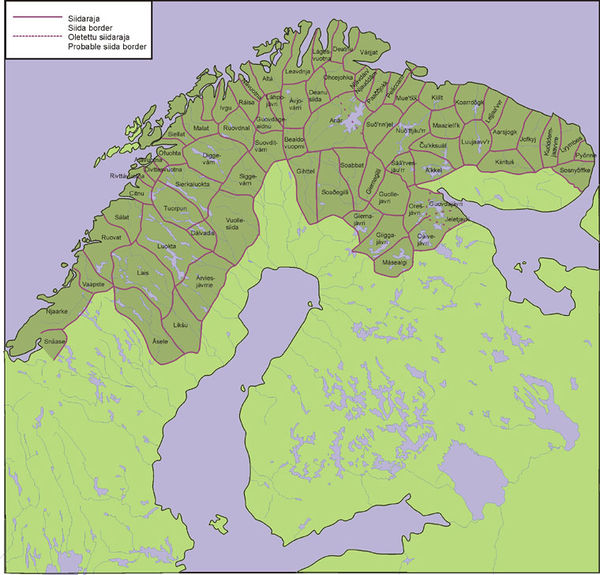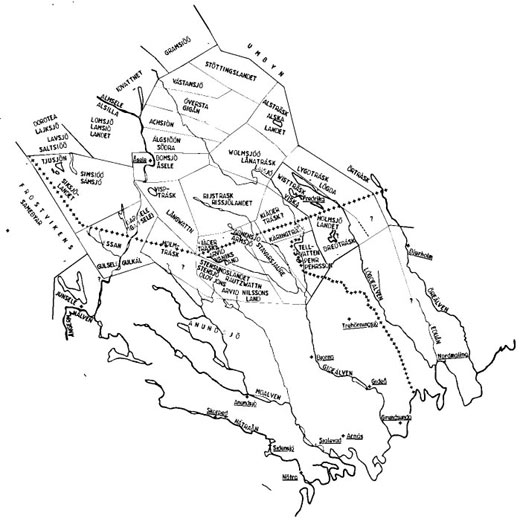Lapp villages and taxation
Lapinkylät ja veromaat
Pohjanlahden rannikkoalueesta lapinrajalla erotettu historiallinen Lapinmaa oli hallinnollisesti jaettu kuuteen erilliseen alueeseen: Ångermanlannin, Uumajan, Piitimen, Luulajan, Tornion ja Kemin Lappeihin. Lappien alue jakaantui lapinkylien alueisiin ja lapinkylien alueet edelleen sukujen tai perheiden kesken perintö- eli lapinveromaihin.
Nykyisen Suomen alueella on joko kokonaan tai osittain sijainnut 13 lapinkylää. Rounala, Suonttavaara, Peltojärvi, Teno ja Utsjoki ovat kuuluneet Tornion Lappiin. Maanselkä, Kitka, Kuolajärvi, Keminkylä, Sompio, Sodankylä, Kittilä ja Inari kuuluivat Kemin Lapin alueeseen. Tutkijat ovat lähteneet siitä, että alueellinen jako lapinkyliin ja perintömaihin on alunperin ollut saamelaisen yhteiskunnan omaperäinen maankäyttö-instituutio. Kansallisvaltioiden otteen vahvistuessa Lapinmaassa tämä aluejako otettiin myös osaksi hallinnollista jaotusta mm. oikeuslaitoksen toiminnassa ja verotuksessa.
Lapinkylästä käytetään myös saamenkielistä sanaa 'siida'. Yleensä ilmaisujen välillä ei tehdä eroa, mutta alunperin itäsaamelaisella alueella käytössä olleen siida-sanan voidaan myös katsoa viittaavan erityisesti kyläyhteisöön, jossa muun muuassa elinkeinoja harjoitettiin yhteiseen lukuun.
Saamelaisten historiaa koskevassa tutkimuksessa on oletettu, että metsästykseen, kalastukseen ja pienimuotoiseen poronhoitoon perustuva lapinkyläjärjestelmä olisi vallinnut koko sillä alueella, jota saamelaiset ovat alunperin asuttaneet, mutta esimerkiksi nykyisen Pohjois-Ruotsin alueelta todisteita autonomisista lapinkylä-yhteiskunnista ei ole juurikaan säilynyt, vaan maankäyttö näyttää ensisijaisesti tapahtuneen veromaiden puitteissa. Säännöllisiä käräjiä alettiin Lapinmaassa pitää noin 1600-luvun puolivälistä lähtien ja oikeuden pöytäkirjoista käy selville, että nykyisen Suomen alueella sijainneessa Kemin Lapin lapinkylissä metsäsaamelaisen yhteisön jäsenet harjoittivat oman lapinkylän alueella säänöllisen vuotuiskierron mukaan pääelinkeinona peuran- ja majavanpyyntiä sekä kalastusta, minkä lisäksi he omistivat jonkin verran poroja. Vorrenin mukaan myös nykyisen Finnmarkenin alueella maankäyttö on tässä suhteessa vastannut eteläisemmän alueen maankäyttöä. Lapinkylillä oli toisiaan vastaan kiinteät rajat, joiden sijainti määriteltiin rajamerkkien avulla. Tällaisina saattoivat tulla kysymykseen erilaiset maastokohdat (vaarat, joet, järvet) tai tehdyt rajamerkit (kivirakennelmat ym.). Lapinkylien välisiä rajariitoja esiintyi erityisesti nykyisen Suomen puolella sijainneiden lapinkylien välillä. Rajan sijaintia koskeva erimielisyys liittyi yleensä siihen, kumman kylän alueeseen jokin metsästysalue, järvi tai kalapaikka kuului. Mikäli riidassa ei päästy sovintoon, asiajouduttiin viemään tuomioistuimeen, joka ratkaisi riidan soveltaen laillisen rajan määräämistä koskevia säädöksiä, samalla tavoin kuin muuallakin valtakunnan alueella.
Lapinkylän sisällä sijaitsivat yksityiset perheiden tai sukujen hallinnassa olleet perintömaat (arfweland), joista myöhemmin ryhdyttiin käyttämään nimistystä veromaa (skatteland). Yksittäisten veromaiden koko saattoi vaihdella muutamasta neliökilometristä varsin laajoihin alueisiin. Samalla tavoin kuin lapinkylien rajoista, myöskin veromaiden rajoista syntyi erimielisyyttä ja rajojen sijainnista käytiin oikeutta. Pääsääntöisesti jokaisella lappalaisella oli veromaansa alueella yksinoikeus elinkeinojensa harjoittamiseen, mutta ainakin nykyisen Suomen metsäalueella sijainneissa lapinkylissä peuranmetsästystä harjoitettiin lapinkylän aluella yhteiseen lukuun. Täyspaimentolaisen poronhoidon yleistyessä käytännöksi muodostui, että saman veromaan alueella saattoi oleskella useita perheitä. Lapinkylän alueella saattoi myös olla yhteisessä käytössä olevia alueita. Aina vuoden 1695 verouudistukseen asti kukin lapinveromaa muodosti verotuksen perusyksikön, mutta verouudistuksen jälkeen kunkin lapinkylän alueella asuneet lappalaiset vastasivat yhteisesti veronmaksusta.
Pääsääntöisesti oikeus lapinveromaahan kulki perintönä sukupolvelta toiselle. Veromaan haltija saattoi kuitenkin myös luovuttaa oikeutensa toiselle: veromaita oli mahdollista myydä, vaihtaa, pantata, testamentata jne. samalla tavalla kuin yksityisessä omistustuksessa olleita kiinteistöjä. Oikeustieteeellisessä tutkimuksessa onkin viime aikoina esitetty, että koska lapinveromaat oli oikeudellisesti rinnastettu yksityisessä omistuksessa olleisiin kiinteistöihin, myös lapinveromaan haltijana olleen lappalaisen oikeus tulisi vastaavasti ymmärtää samanlaiseksi oikeudeksi, joka verotalonpojalla oli verotaloonsa.
Lapinkylien ja lapinveromaiden häviämiseen johtanut muutos saapui kahdelta suunnalta. Vuonna 1673 ja 1695 annettujen lapinmaiden asutusplakaattien seurauksena yhä enemmän suomalaisia ja ruotsalaisia uudisasukkaita saapui etelästä lapinkylien alueelle. Lapinkylien elinkeinollinen pohja ei kestänyt sitä, että tulokkaat ryhtyivät kilpailemaan metsästyksessä ja kalastuksessa alueen alkuperäisten asukkaiden kanssa. Suunnilleen samoihin aikoihin lännestä nykyisen Suomen alueelle saapunut täysnomadismi (nomadismi) tuli muuttamaan perinteisen maankäyttöjärjestelmän. Ekstensiivinen poronhoito (suurporonhoito) perustui suuriin porotokkiin ja uusien laidunalueiden käyttöönottoon. Alkuperäisille lapinkylille tyypillinen yhteisöllisyys, sekä metsästykseen ja kalastukseen pohjautuva elinkeinoperusta, korvautui yksilöllisellä, lähes yksinomaan poronhoitoon keskittyvällä elinkeinolla. Kolttasaamelaistn alueelle täyspaimentolaisuus saapui vasta 1800-luvulla.
Vanha aluejako saattoi kuitenkin säilyä myös muuttuneissa olosuhteissa. Yksityisiä veromaita käytettiin Enontekiön länsiosissa ennen vuotta 1750 yksityisesti porojen laiduntamiseen. Veromaa-jaotusta noudatettin vielä 1800-luvulla eräillä nykyään Ruotsiin kuuluvilla alueilla. Vähitellen vanha maankäyttöjärjestys joutui kuitenkin väistymään. Nykyisen Suomen alueella alkuperäinen maankäyttöjärjestys säilyi pisimpään Inarissa, mutta pisimpään metsäsaamelainen lapinkyläjärjestelmä säilyi kolttien alueella, jossa elinkeinoperusta ja aluejako jatkui muuttumattomana nykyaikaan asti. Eristyneessä Suonikylässä toiseen maailmansotaan asti säilynyt perinne oli relikti vanhasta maankäyttöjärjestelmästä, jota aikoinaan noudatettiin suuressa osassa nykyistä Fennoskandiaa.
Sanana lapinkylä säilyi poronhoitoon liittyen. Muutamasta tai jopa yhdestä poronhoitajaperheestä käytetty ilmaus lapinkylä tai porokylä kuvasi kyllä sitä, että kyseiset henkilöt harjoittivat poronhoitoa yhteiseen lukuun, mutta muilta osin asiallinen yhteys vanhoihin lapinkyliin oli kadonnut. Lainsäädännössä lapinkylä-sana (lappby) säilyi Ruotsin poronhoitolainsäädännössä (vuoden 1886 poroelinkeinolaki). Elinkeinojen harjoittamiseen liittyen Ruotsin nykyiset saamelaiskylät voidaan myös nähdä vanhan lapinkylä-järjestelmän jatkajina.
Lapp villages and taxation
The historical area of Lapland was separated by a border from the area around the Gulf of Bothnia. It was administratively divided into six separate areas: Ångermanland, Ume, Pite, Lule, Torne ja Kemi Lapland. These were in turn divided into Lapp villages, which were further subdivided between clans and families into inherited lands (arfweland), later known as Lapp tax lands (skatteland).
At the beginning of the Modern Age, altogether thirteen Lapp villages were partly or wholly located on what is the territory of present-day Finland: Rounala, Suonttavaara, Teno and Utsjoki belonged to Torne Lapland, while Maanselkä, Kitka, Kuolajärvi, Keminkylä, Sompio, Sodankylä, Kittilä, Peltojärvi and Inari were part of Kemi Lapland (map). This division into Lapp villages and inherited lands represented a land distribution institution that was an original feature of Lapp society. However, as the nation states tightened their grip on Lapland, this division also became in part an administrative partition which was used for example for the purposes of taxation and the judicial system.
The Saami word siida is also used to refer to the Lapp village. Usually no distinction is made between the two expressions, but siida can also be regarded as referring specifically to a village community comprising several families who were usually related to one another.
It has been assumed that the Lapp village system, based as it was on hunting, fishing and small-scale reindeer husbandry, covered the whole area originally inhabited by the Lapps. In western Lapland, a shift to full-scale nomadism, in which the herders followed their herds over wide areas, had begun already in the Middle Ages. Regular district court sessions began to be held in Lapland from about half-way through the seventeenth century, and it is evident from the court records that the source of livelihood of the Lapps of Kemi Lapland at least was hunting (mainly fur animals and wild reindeer) and fishing, which they practised within the territory of their own Lapp villages according to a regular annual cycle. They also owned some domesticated reindeer.
The Lapp villages were separated from each other by fixed borders, which were defined by boundary marks such as geographical landmarks (hills, rivers, lakes) or man-made signs such as piles of stones. Border disputes were particularly prevalent between those Lapp villages that were located in the territory of present-day Finland. Differences of opinion about the precise position of the border were usually connected with a dispute about which of two Lapp villages hunting grounds, a lake or fishing grounds belonged to. If no agreement could be reached, the matter was taken to court, where the dispute was solved according to the regulations concerning the determination of a legal border, just as elsewhere in the realm.
Within the Lapp villages there were private inherited lands (arfweland) belonging to individual families or clans, for which the term Tax land" (skatteland) was later adopted. The size of individual tax lands might vary from a few square kilometres to fairly extensive areas. Just as in the case of borders between the Lapp villages, there were disputes about the borders between tax lands, and these disputes were also taken to court. In principle, every Laplander had an exclusive right to pursue his livelihood on his own tax land, but at least in the Lapp villages that were situated in the forest areas of the territory belonging to modern Finland, wild reindeer and beaver were hunted over the area of the village for the benefit of the whole community. The territory of the siida was used communally for practising common means of livelihood, while individual occupations were pursued on each person s own inherited land. On the other hand in what is today northern Sweden, practically no evidence of the existence of autonomous Lapp village societies has survived; rather the distribution of the land seems to have been within the framework of inherited lands.
With the spread of a fully nomadic way of life in reindeer herding, it became the practice for several families to sojourn on the same Lapp tax lands. Sometimes the Lapp villages also had areas that were in common use. Up to the taxation reform of 1695, each piece of tax land had constituted a basic tax unit, but after the reform the Lapps who inhabited given village were jointly responsible for the payment of tax.
Generally, the title to a unit of tax land was passed down from one generation to another. However, the holder of tax lands might also cede his title to another person; thus tax lands could be sold, exchanged, pawned, bequeathed, etc. in the same way as privately owned real estate. Indeed, it has been proposed in jurisprudential research that, since the Lapp tax lands were legally regarded as equivalent to privately owned real estate, the right of Lapps as title holders of the tax lands should correspondingly be regarded as the same kind of right as that of the holder of the title to a farm.
The change that led to the disappearance of Lapp villages and Lapp tax lands came from two directions. As a consequence of two placards regarding the settlement of Lapland issued in 1673 and 1695, more and more Finnish and Swedish settlers began to move from the south into the territory of the Lapp villages. The subsistence base was unable to support the population when the newcomers began to compete with the indigenous inhabitants in hunting and fishing. About the same time, a fully nomadic way of life arrived in the area of present-day Finland from the west, and it changed the traditional system of land use. Large-scale reindeer husbandry was based on large herds and the acquisition of new grazing ranges. The communal nature of the original Lapp villages and a way of life based on hunting and fishing were replaced by a means of livelihood that depended almost exclusively on reindeer husbandry. In the northern regions full nomadism spread from the west eastwards as far as the lands of the Skolts.
The old distribution of land did nevertheless survive in some places despite the changed circumstances. In the western parts of the Enontekiö region, tax lands were still used for the private herding of reindeer up to the mid-seventeenth century. And the traditional division into tax lands was still practised in areas that are part of modern Swedish Lapland. Gradually, however, the old system of land use disappeared. In the area of present-day Finland, the original system of land use survived longest in the Inari region, but the Lapp village system itself lived on longest in the area inhabited by the Skolts, where the subsistence base and the division of land remained unchanged down to present times. The tradition that lived on in the isolated area of Suonikylä was a relic of an ancient system of land use that was once practised over a large part of Fennoscandia.
As a term, Lapp village survived in connection with reindeer husbandry. With reference to a few or even a singe reindeer-herding family, the expression Lapp village or reindeer village describes the fact that the persons in question herded their reindeer communally, but any other factual connection with the old Lapp villages had disappeared. In law, the term (lappby) survived in Swedish legislation concerning reindeer husbandry (e.g. in the Reindeer Husbandry Act of 1886). With regard to livelihood, the present-day Saami villages in Sweden can perhaps also be regarded as descendants of the old Lapp village system.

